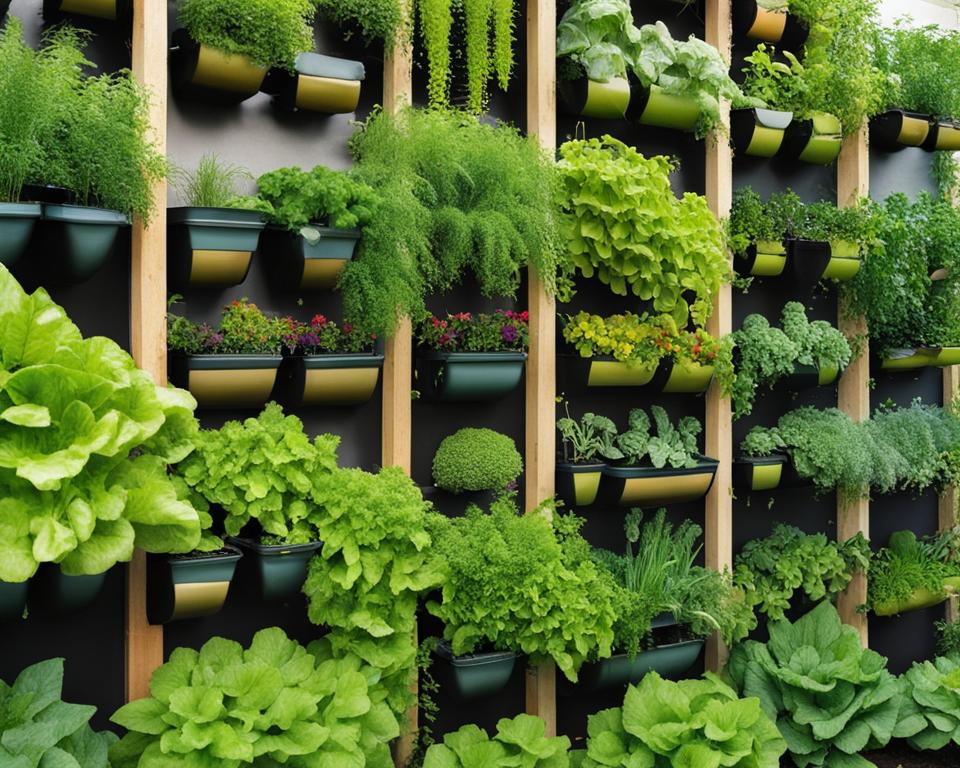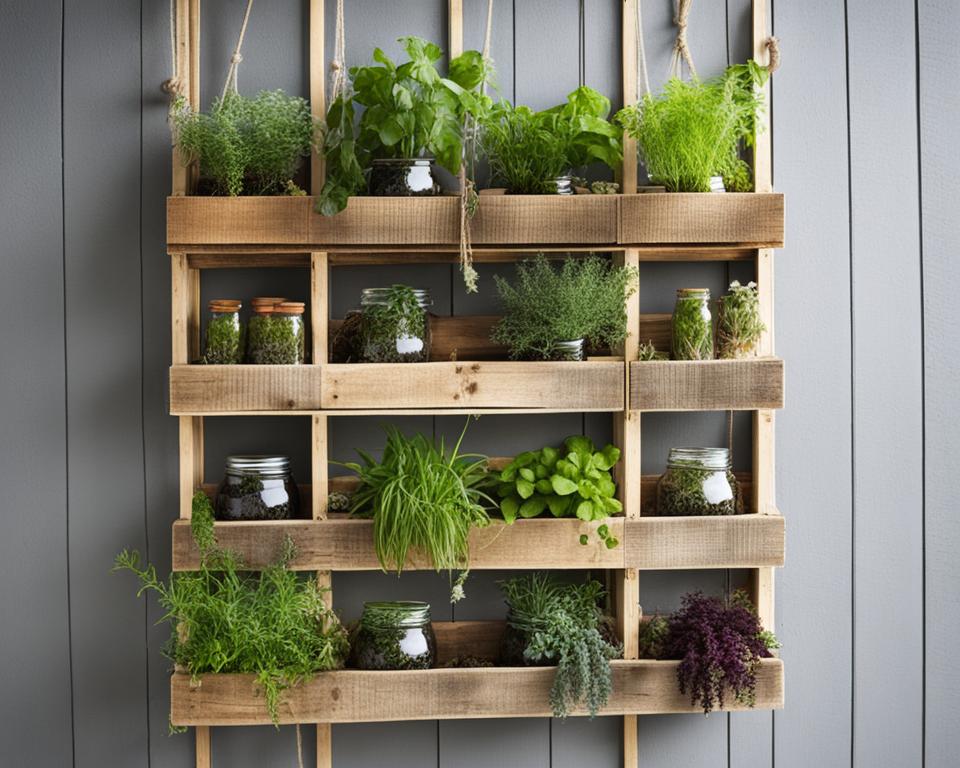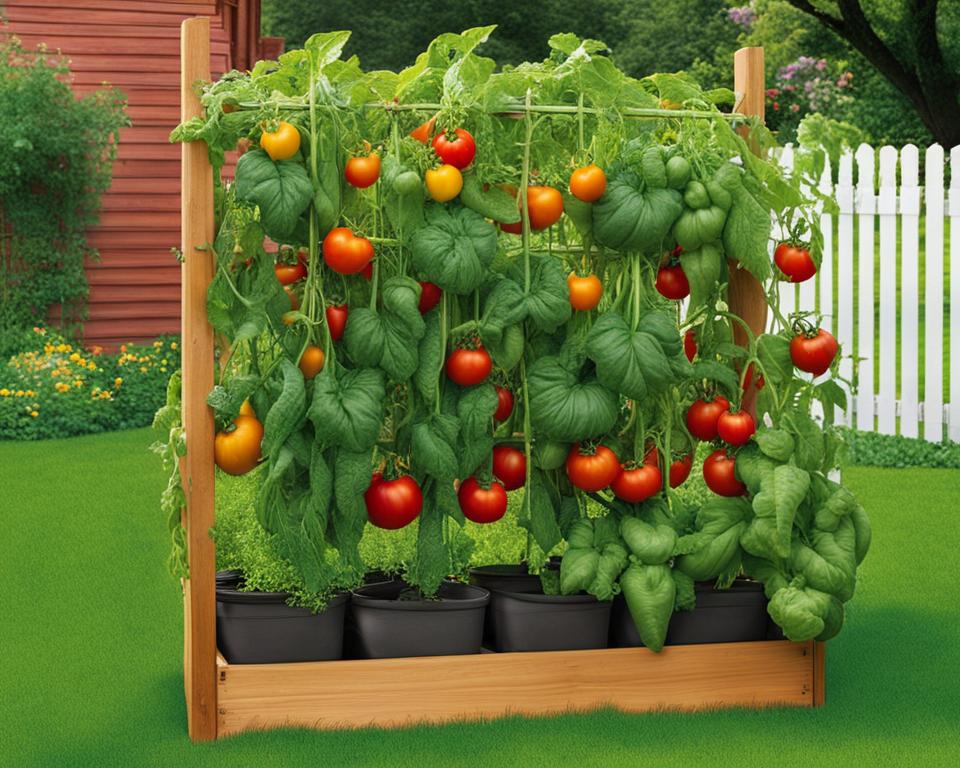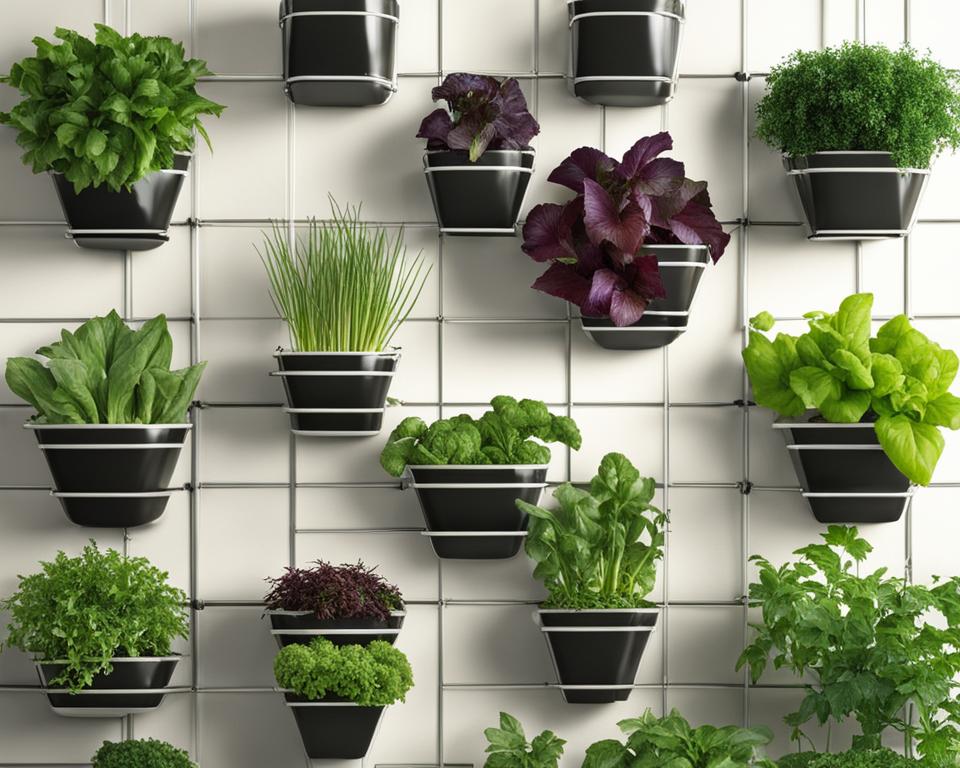Are you looking to make the most of your limited gardening space? Vertical gardening systems for vegetables are the answer! By utilizing structures such as trellises, fences, and cages, you can maximize your harvest without needing a large plot of land. Vertical gardening offers numerous benefits, including increased yields, easier maintenance and harvesting, reduced risk of disease, and improved sun exposure for healthier growth.
Key Takeaways:
- Vertical gardening systems allow you to grow more vegetables in smaller spaces.
- Utilize structures like trellises, fences, and cages to increase the available growing area.
- Vertical gardens offer benefits such as increased yields, easier maintenance, and reduced risk of disease.
- Choose the right crops for vertical gardening, such as pole beans, climbing peas, and vining tomatoes.
- Efficient irrigation systems can automate the watering process in vertical gardens.
Benefits of Vertical Gardening
Vertical gardening offers several benefits for vegetable growers. Firstly, it allows for increased yields by maximizing the use of available space. Plants can reach higher levels, reducing the need for bending and kneeling during maintenance and harvesting.
“Vertical gardening is a practical and efficient way to maximize your harvest.”
Vertical growth also helps prevent plant problems, as foliage and fruit are elevated off the ground, making them less susceptible to diseases and pests. Improved air circulation in vertical gardens leads to faster drying after watering, reducing the risk of moisture-loving fungi. Additionally, vertical gardening provides better sun exposure, resulting in healthier growth. This method is particularly beneficial for small space and urban vegetable gardening.
To better understand the advantages of vertical gardening, let’s take a look at a comparison table:
| Advantages | Vertical Gardening | Traditional Gardening |
|---|---|---|
| Yield | Maximized use of space leads to increased yields | Limited space may result in lower yields |
| Maintenance | Reduced need for bending and kneeling during maintenance | More physically demanding |
| Disease and Pest Control | Elevated foliage and fruit reduce the risk of diseases and pests | Increased risk of diseases and pests due to ground contact |
| Air Circulation | Improved air circulation leads to faster drying and reduces the risk of fungi | Less air circulation can lead to slower drying and increased risk of fungi |
| Sun Exposure | Vertical gardening provides better sun exposure for healthier growth | Less sun exposure may result in slower growth and lower yields |
As seen in the table, vertical gardening offers numerous advantages over traditional gardening methods. By adopting vertical gardening techniques, gardeners can maximize their yield, simplify maintenance, reduce disease risk, promote faster drying, and improve sun exposure for their vegetable plants.
References:
- “Vertical Gardens.” National Gardening Association. Accessed June 22, 2022. https://www.gardeners.com/how-to/vertical-gardening/5063.html
- “Vertical Vegetable Gardening.” University of Missouri Extension. Accessed June 22, 2022. https://extension2.missouri.edu/g6460
- “Urban Vegetable Gardening: Urban Vegetable Gardens And Vegetable Gardens In Cities.” Gardening Know How. Accessed June 22, 2022. https://www.gardeningknowhow.com/edible/vegetables/vgen/urban-vegetable-gardening.htm
Choosing the Right Plants for Vertical Gardening
When it comes to vertical gardening, selecting the right plants is essential for a successful and thriving vegetable garden. Not all plants are well-suited for growing vertically, so it’s important to choose crops and cultivars that can be trained to grow up and off the ground. Vining, rambling, and sprawling plants are ideal candidates for vertical gardening as they can be easily guided and supported on trellises, fences, and other structures.
One important consideration when choosing plants for vertical gardening is their light requirements. Most vegetables typically need 6 to 8 hours of direct sunlight to thrive. Therefore, it’s crucial to select a location that receives adequate sunlight, particularly during midday or the afternoon. This will maximize sun exposure and promote healthier growth and higher yields.
Some recommended vegetables for vertical gardening include pole beans, climbing peas, vining tomatoes, and sprawling varieties of zucchini, cucumber, melon, and squash. These plants not only adapt well to vertical growth but also offer a bountiful harvest. By choosing the right plants, you can create a vibrant and productive vertical garden that maximizes your gardening space.
Choosing the Right Plants for Vertical Gardening
| Plant | Sunlight Requirements | Type |
|---|---|---|
| Pole Beans | Full Sun | Vining |
| Climbing Peas | Full Sun to Partial Shade | Vining |
| Vining Tomatoes | Full Sun | Vining |
| Zucchini | Full Sun | Sprawling |
| Cucumber | Full Sun | Sprawling |
| Melon | Full Sun | Sprawling |
| Squash | Full Sun | Sprawling |
By incorporating these plants into your vertical garden, you can enjoy a diverse and productive vegetable garden that maximizes space and yields.
Types of Vertical Gardening Structures

Vertical gardening offers a range of structures that can be used to support and train plants to grow vertically. These structures not only provide the necessary support but also add beauty and visual interest to your vegetable garden. Here are some of the popular types of vertical gardening structures:
Trellises:
Trellises are the most common and versatile structures used in vertical gardening. They can be made from wood, metal, or even PVC pipes. Trellises provide a framework for plants to climb on, supporting them as they grow vertically. Vining plants like pole beans and sweet peas thrive on trellises, creating a stunning display of foliage and flowers.
Arches and Tripods:
Arches and tripods are excellent choices for vertical gardening, especially if you want to create an eye-catching focal point in your garden. These structures provide support for climbing plants such as cucumbers, squash, and melons. By training these plants to grow up arches or tripods, you can save space and showcase their beautiful blooms and fruits.
Wall-mounted Planters:
If you have limited ground space, wall-mounted planters are a great option for vertical gardening. These planters can be attached to walls or fences, allowing you to grow a variety of vegetables and herbs without taking up valuable floor space. Wall-mounted planters are perfect for small gardens or balconies, offering a vertical growing solution that is both functional and aesthetically pleasing.
Hanging Baskets and Tower Planters:
Hanging baskets and tower planters are suitable for plants with trailing or cascading growth habits. These structures are ideal for growing vine tomatoes, strawberries, and herbs. Hanging baskets can be hung from pergolas or other structures, while tower planters can be stacked to create a vertical garden that takes advantage of vertical space.
Wall-mounted Pots:
Wall-mounted pots are a creative way to incorporate vertical gardening into your vegetable garden. These pots can be attached to walls or fences, allowing you to grow a variety of plants in a small space. Whether you choose to plant herbs, flowers, or even compact vegetable varieties, wall-mounted pots can add a unique and charming touch to your garden.
Complete Table: Types of Vertical Gardening Structures
| Structure | Description | Recommended Plants |
|---|---|---|
| Trellises | Framework for plants to climb on | Pole beans, sweet peas |
| Arches and Tripods | Eye-catching focal point, support for climbing plants | Cucumbers, squash, melons |
| Wall-mounted Planters | Attached to walls or fences, ideal for small spaces | A variety of vegetables and herbs |
| Hanging Baskets and Tower Planters | Suitable for trailing or cascading plants | Vine tomatoes, strawberries, herbs |
| Wall-mounted Pots | Attached to walls or fences, creative vertical option | Herbs, flowers, compact vegetable varieties |
DIY Vertical Gardening Ideas

Are you looking for creative ways to maximize your vegetable garden space? Try these DIY vertical gardening ideas that not only save space but also add visual interest to your garden. Whether you have a small backyard or an urban balcony, these projects are perfect for any vegetable garden enthusiast.
1. Living Wall
Create a stunning living wall by attaching a trellis panel to a wall and planting pots with herbs, vegetables, or flowers. This vertical gardening idea not only saves space but also transforms a plain wall into a vibrant, green focal point. Choose plants that thrive in vertical conditions and enjoy the beauty and functionality of a living wall.
2. Vegetable Arch
Build a vegetable arch using galvanized metal uprights and cattle panels that can be clad with climbing crops like beans, cucumbers, and squash. This vertical gardening structure adds a decorative element to your garden while maximizing the use of vertical space. Create a lush vegetable tunnel and enjoy the beauty of your harvest.
3. Bean Teepee
Construct a classic bean teepee using bamboo canes or other long, straight prunings. This simple and cost-effective DIY vertical gardening project creates a fun play space for children while providing a vertical growing area for beans. Watch as the bean plants climb and create a cozy hideaway in your garden.
4. Pallet Planters
Repurpose old wooden pallets into pallet planters by filling them with potting soil and planting herbs or vegetables. This eco-friendly vertical gardening idea not only saves space but also adds a rustic charm to your garden. Hang the pallet planters on a wall or fence and enjoy the convenience of having fresh herbs or vegetables at your fingertips.
Get creative with these DIY vertical gardening ideas and make the most of your vegetable garden space. From living walls to bean teepees, there’s a project for every gardener’s taste and skill level. Start your own vertical garden and enjoy the beauty and abundance it brings.
Best Plants for Vertical Gardening

When it comes to vertical gardening, choosing the right plants is essential for successful growth. Certain vegetables are well-suited for vertical gardens, allowing you to maximize your space and yield. Some of the best plants for vertical gardening include zucchinis, tomatoes, cucumbers, peas, pole beans, squash, melons, and eggplants. These vegetables have natural climbing tendencies and can be easily trained to grow vertically using trellises, stakes, or other supports.
One of the advantages of vertical gardening is improved air circulation, which reduces the risk of diseases and pests. By growing these plants vertically, you can keep foliage and fruit elevated off the ground, making them less susceptible to soil-borne pathogens. Additionally, vertical gardening simplifies harvesting as plants are more accessible and easier to maintain. With proper care and support, these vegetables can flourish in a vertical garden.
When considering which plants to choose for your vertical garden, it’s important to assess their specific needs. Some vegetables, such as zucchinis and tomatoes, require sturdy support to accommodate the weight of their fruits. Cucumbers, peas, and pole beans naturally climb and can be guided up trellises or netting. Squash and melons may need additional support, such as slings, as their fruits grow. Eggplants benefit from vertical growth but may require cages or stakes for support. By tailoring the vertical gardening techniques to specific vegetables, you can optimize their growth and yield.
Table: Best Plants for Vertical Gardening
| Vegetables | Growth Habit | Support Needed |
|---|---|---|
| Zucchinis | Vining | Sturdy support for fruits |
| Tomatoes | Determinate or indeterminate | Sturdy support for fruits |
| Cucumbers | Vining | Trellises or netting |
| Peas | Climbing | Trellises or netting |
| Pole Beans | Vining | Trellises or netting |
| Squash | Sprawling | Slings for fruit support |
| Melons | Sprawling | Slings for fruit support |
| Eggplants | Upright | Cages or stakes |
By selecting the best plants for vertical gardening and providing them with the appropriate support, you can create a thriving vertical garden that maximizes space and yields abundant harvests.
Pros of Vertical Vegetable Gardening

Vertical vegetable gardening offers numerous advantages for those looking to grow their own fresh produce. Whether you have limited space in your backyard or live in an urban setting, vertical gardening systems for vegetables can help you maximize your harvest. Here are some key benefits of vertical vegetable gardening:
Easier Maintenance and Harvesting
One of the major advantages of vertical gardening is that it simplifies maintenance and harvesting tasks. By training your plants to grow vertically, you can reduce the need for bending and kneeling, making it easier on your back and knees. This is especially beneficial for older individuals or those with physical limitations. Additionally, vertical gardens allow for better access to the plants, making it simpler to prune, water, and harvest your vegetables.
Increased Yield in Limited Space
Vertical gardening systems for vegetables are perfect for those with limited gardening space. By utilizing structures such as trellises, fences, or cages, you can make the most of your vertical space and grow more plants. This can significantly increase your vegetable yield, providing you with a bountiful harvest. Vertical gardening is particularly advantageous for small backyard gardens or urban settings where horizontal space is limited.
Reduced Disease Risk and Improved Sun Exposure
Another benefit of vertical vegetable gardening is the reduced risk of diseases and pests. By elevating your plants off the ground, you can minimize the chances of soilborne diseases and pests attacking your vegetables. Furthermore, vertical gardening promotes better air circulation around the plants, leading to faster drying after watering. This reduces the risk of moisture-loving fungi and promotes healthier growth. Additionally, vertical gardens offer improved sun exposure for your plants, ensuring they receive the necessary sunlight for optimal growth and development.
With its many advantages, vertical vegetable gardening is a practical and efficient way to grow your own vegetables, even in limited space. It simplifies maintenance and harvesting, increases yields, and reduces the risk of diseases and pests. Whether you’re a seasoned gardener or just starting out, vertical gardening systems for vegetables are definitely worth considering.
Table: Pros of Vertical Vegetable Gardening
| Advantages |
|---|
| Easier Maintenance and Harvesting |
| Increased Yield in Limited Space |
| Reduced Disease Risk and Improved Sun Exposure |
Vertical Gardening for Different Vegetables
When it comes to vertical gardening, different vegetables have specific requirements and considerations. By tailoring your approach to each plant, you can optimize their growth and maximize your harvest. Here’s a breakdown of some popular vegetables and how to best grow them vertically:
Zucchinis and Tomatoes
Zucchinis and tomatoes are heavy-fruited plants that require sturdy support. Trellises or cages can help support the weight of their fruits and prevent them from bending or breaking under their own pressure. By training these plants vertically, you’ll not only save space but also ensure healthier growth and easier maintenance.
Cucumbers, Peas, and Pole Beans
Cucumbers, peas, and pole beans are natural climbers and can be guided up trellises or netting. These plants will happily latch onto vertical structures, making them ideal for vertical gardening. By providing them with the necessary support, you’ll ensure that their vines grow strong and healthy, enhancing their overall productivity.
Squash and Melons
Squash and melons can also be grown vertically, but they may require additional support as their fruits develop. Slings made from fabric or pantyhose can help cradle the growing fruits, preventing them from becoming too heavy for the vines to support. Vertical growth for squash and melons can help protect the fruits from rotting on the ground and make harvesting easier.
Eggplants
Eggplants benefit from vertical growth but may require cages or stakes for support. These plants can become top-heavy as they develop fruits, so providing them with a stable structure is essential. By training eggplants vertically, you can save space and improve air circulation, leading to healthier plants and higher yields.
| Vegetable | Support |
|---|---|
| Zucchinis and Tomatoes | Sturdy trellises or cages |
| Cucumbers, Peas, and Pole Beans | Trellises or netting |
| Squash and Melons | Additional support (e.g., slings) |
| Eggplants | Cages or stakes |
By understanding the unique needs of each vegetable, you can create an efficient and productive vertical garden. With proper support and care, these vegetables will thrive in a vertical gardening system, allowing you to make the most of your available space and enjoy a bountiful vegetable harvest.
Conclusion
After exploring the world of vertical gardening systems for vegetables, it’s clear that this innovative approach offers a wealth of benefits for both experienced and novice gardeners. By harnessing the power of vertical space, you can maximize your harvest, even in smaller gardens or urban settings.
Vertical gardening not only increases your vegetable yields but also simplifies maintenance and harvesting. With plants elevated off the ground, you’ll enjoy reduced disease risk and improved air circulation, leading to healthier growth. Plus, the added convenience of less bending and kneeling makes gardening a more enjoyable experience.
Whether you choose to grow pole beans, climbing peas, vining tomatoes, or sprawling varieties of zucchini, cucumber, melon, and squash, vertical gardening systems provide the support you need to optimize your plants’ growth and yield. By carefully selecting the right plants and structures for your garden, you can create a visually stunning and productive vegetable garden.
So why not give vertical gardening a try? With its space-saving design and numerous advantages, it’s a surefire way to grow more in smaller spaces while enjoying the beauty and bounty of your own vegetable garden.
FAQ
What are the benefits of vertical gardening?
Vertical gardening offers increased yields, easier maintenance, reduced disease risk, and improved sun exposure.
What plants are suitable for vertical gardening?
Ideal plants for vertical gardening include zucchinis, tomatoes, cucumbers, peas, pole beans, squash, melons, and eggplants.
What types of structures can be used for vertical gardening?
Structures such as trellises, tripods, arches, wall-mounted planters, hanging baskets, tower planters, and wall-mounted pots can be used for vertical gardening.
What are some DIY vertical gardening ideas?
DIY vertical gardening projects include creating a living wall, building a vegetable arch, constructing a bean teepee, and repurposing wooden pallets into pallet planters.
What are the best plants for vertical gardening?
Recommended plants for vertical gardening include zucchinis, tomatoes, cucumbers, peas, pole beans, squash, melons, and eggplants.
What are the advantages of vertical vegetable gardening?
Vertical vegetable gardening offers increased yields in limited space, reduced disease risk, easier maintenance, and visually appealing gardens.
How does vertical gardening differ for different vegetables?
Different vegetables require specific support and care in vertical gardening, such as sturdy support for tomatoes and additional slings for squash and melons.
What are the benefits of vertical gardening systems for vegetables?
Vertical gardening systems for vegetables maximize harvests, simplify maintenance, reduce disease risk, and improve sun exposure.

